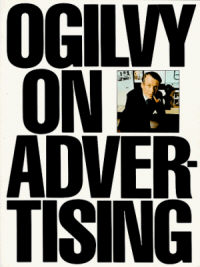 Sadly “David Ogilvy on mobile advertising” will never be written as the great man passed away in July 1999. It would be a great companion to his classic 1993 book “Ogilvy on Advertising“, the cover of which is shown on the left.
Sadly “David Ogilvy on mobile advertising” will never be written as the great man passed away in July 1999. It would be a great companion to his classic 1993 book “Ogilvy on Advertising“, the cover of which is shown on the left.
Having just read the brilliant biography on David Ogilvy “The King of Madison Avenue” by Kenneth Roman, I can’t help but wonder what he would have made of advertising on the mobile phone.
He was a big fan of press and brochure advertising – great photos and long copy, and by his own admission he never really harnessed the creative power of TV. He was also a great fan of direct mail.
Having finished the book over the weekend, it left me thinking about what he would say if he updated his classic book for the current day – with internet and mobile advertising.
He was famous for saying that you had to have a BIG IDEA, and “WE SELL. OR ELSE”. These catchphrases adorn the office of Ogilvy’s London headquarters in Canary Wharf, and having read his biography, they now carry a greater resonance.
David was not a big fan of flashy, “award winning” campaigns – his mission was to make advertising that caused the consumer to buy more of the product – every campaign had to sell. Perhaps he would have seen mobile as an extension of direct mail, and focused on the unique personalisation possibilities of this medium.
I am yet to see an “award winning” mobile WAP banner, and probably never will. The power of mobile is not in what you can push to the tiny screen, but how through privacy, preference and permission you can turn this new medium into a tool that allows a relationship with a brand, product or service.
In the final chapter “The burr of singularity” of Roman’s biography on Ogilvy he states (page 229):
 “Every time a new advertising medium appears, the end is predicted for whatever medium it appears to replace. When TV came in, it was going to be the end of radio, Radio didn’t go away; it changed. There are now more stations with a wider variety of programming, and who would have thought that one day we might pay for radio via satellite? Classified advertising, a big revenue source for newspapers, has largely gone on the internet, and big-city newspapers are merging or closing. But community and special interest newspapers are growing”.
“Every time a new advertising medium appears, the end is predicted for whatever medium it appears to replace. When TV came in, it was going to be the end of radio, Radio didn’t go away; it changed. There are now more stations with a wider variety of programming, and who would have thought that one day we might pay for radio via satellite? Classified advertising, a big revenue source for newspapers, has largely gone on the internet, and big-city newspapers are merging or closing. But community and special interest newspapers are growing”.
As I’ve been saying for a long time, mobile is a unique new channel, and it will take a while for all parts of the ecosystem to step up and use its full potential. I hope I am helping to drive this change in some small way.
In the final paragraphs of Roman’s book (again on page 229) he sums up:
“Like all businesses, advertising is changing. This could be the most exciting time to be in advertising. Technology is creating new opportunities to reach consumers – and measure the benefits of spending.
What advertising delivers is ideas. … Ogilvy would not recognise much of the new landscape, but he would applaud the growth of disciplines that can be measured such as direct marketing.”
That last sentence rings true. Mobile will probably become the most measurable type of direct marketing we will come across – if executed properly.
I think if David Ogilvy was alive today, he would have grasped the mobile advertising opportunity with both hands, given his direct marketing roots, and directed his staff to focus on the utility of the channel, rather than trying to squeeze 50 years of advertising norms onto a small screen.
If you are in advertising, you need to grab Kenneth Roman’s biography on David Ogilvy. It is available from the publisher Palgrave Macmillan or via Amazon. He did his homework for this book, and has a unique insight into Ogilvy, not only because he is a former CEO of Ogilvy and Mather Worldwide, but he conducted over 100 interviews for the book – all referenced in great detail at the end.
This is a fantastic book. It sells itself and I think David would have been proud of the result.
